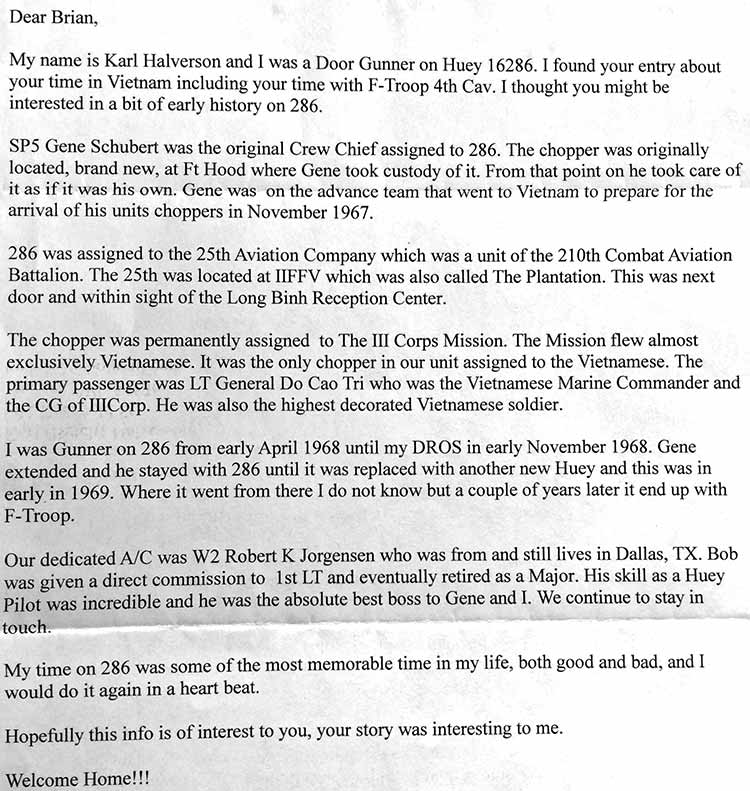
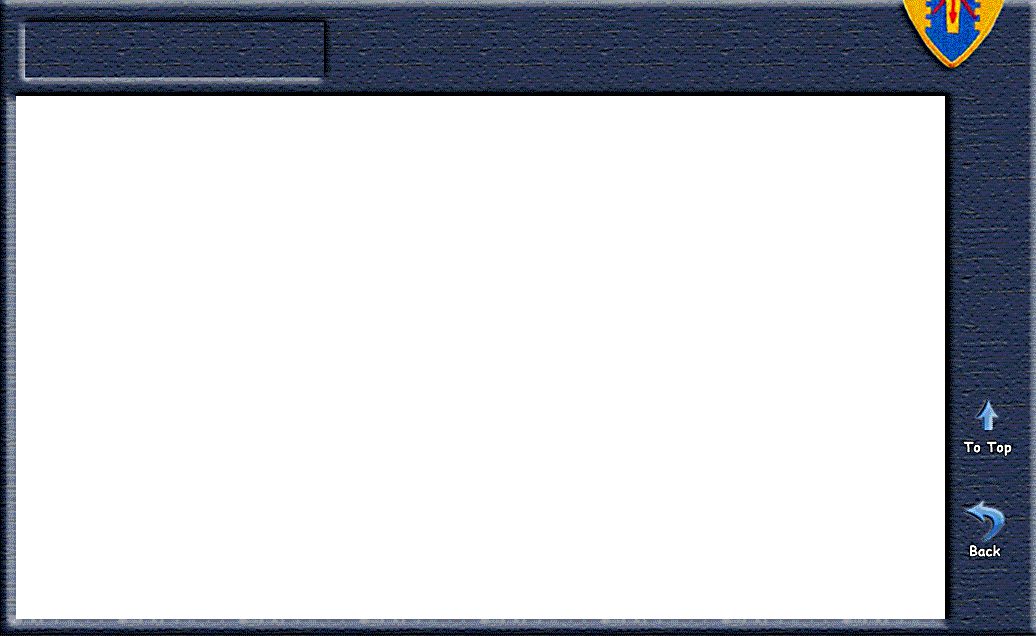
.....................................................................................................................................................................................
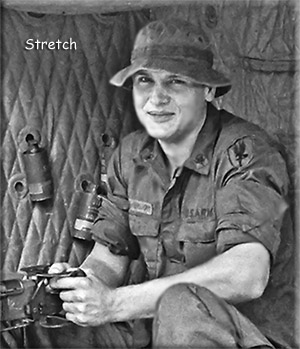 I was born in 1952 and raised in Charlotte, North Carolina graduating from Garinger High School in 1970. After high school I tried college for a summer semester (at N.C.State U, where my other brother was already half-way through) but I wasn’t all that interested in college yet so I went to work for Southern Bell as a 4A frame man. I received my draft notice in the mail from President Nixon in late August or September 1971 and was ordered to report for induction mid-October 1971. My draft number was 33, which has been a lucky number for me since. In Army parlance, I was now referred to as a “U.S.” (draftee).
I was born in 1952 and raised in Charlotte, North Carolina graduating from Garinger High School in 1970. After high school I tried college for a summer semester (at N.C.State U, where my other brother was already half-way through) but I wasn’t all that interested in college yet so I went to work for Southern Bell as a 4A frame man. I received my draft notice in the mail from President Nixon in late August or September 1971 and was ordered to report for induction mid-October 1971. My draft number was 33, which has been a lucky number for me since. In Army parlance, I was now referred to as a “U.S.” (draftee).
My nickname in the Army was “Stretch” because I was tall and lanky and had played tennis in high school and because of my long arms I could stretch out to get the ball.
At the Induction Center everyone took a physical and also a battery of tests to help identify their particular skills and interests. I had been an amateur radio operator for three+ years or so and I enjoyed electricity and electronics and morse code so I hoped to be a radio operator. Like most young guys I did really well on the physical but was told I flunked the morse code test and that the Army thought I would do best in the Infantry, as a 11C, mortar crewman - so mortars it was!
The last event at the Induction Center was to line us all up and have every fifth man step to the right. Afterwards a Marine gunnery sergeant stepped up and asked each fifth man if they would like to volunteer for the Marines. All that volunteered were taken elsewhere, and if the answer was no that man went back in the line and the next fellow behind him stepped out and was asked the same question… Luckily I wasn’t asked (or I probably would have volunteered).
We were bused to Fort Jackson, SC where I took Basic and AIT (Advanced Infantry Training) - my Basic company was A-1-1 and AIT was D-12-3, both housed in old WWII wooden barracks on "tank hill”. The slightly older guys with some college were typically made squad leaders. The Army was always asking for volunteers but you didn’t find out what you were volunteering for until after you raise your hand… but I learned volunteering was usually a good thing. For one of these details I qualified to drive a truck and drove ammo out to the firing ranges, which sure beat running out there in formation in full pack. Another benefit was staying afterwards and getting to shoot up any left-over ammo.
I liked the firing ranges, especially watching 50 caliber armor-piercing rounds go through both sides of a APC - I decided right then I didn’t want to ever be in an APC. I liked the M-16 and was a good quick shot with it in the daytime but I just about flunked night-firing though (shooting too high over the target). I also liked the night navigation, walking through the woods with a compass while aircraft dropped flares or practiced taking aerial photos by dropping 55-gallon flash bulbs.
A few days into Basic training a few of us volunteered for Vietnam (most non-Aviation guys at that time were destined for Germany or Korea or Airborne school). Older friends of mine in my neighborhood had already done tours and I enjoyed their stories and had grown up watching Vietnam war news on TV so I figured I needed to also experience it in person. After signing up for Vietnam I was referred to as a “RA” (Regular Army).
After AIT I did a week or maybe two of “hometown recruiting duty", standing around in stores in khaki uniform handing out Army brochures and telling everyone how great the Army was.
In late May or early June 1972 I flew to Oakland (my first airplane ride) and had the obligatory T-bone steak meal prior to flying to Vietnam via Anchorage and Yakota, Japan. Upon arrival things were really busy at the replacement depo near Tan Son Nhut with lots of grunts from the 101st and 1st Cav divisions standing down and heading home. They had a good time messing with me in my newbie fatigues and ball cap and one of the 101st guys (another 11C) gave me his very weathered boonie cap.
After a few days I was sent to E Co 52 14th Inf, one of the two American security companies guarding Long Binh perimeter. I learned much later that this unit was detached from the 25th Infantry Division after it left country. The company area was in a grove of rubber trees and there was an overgrown derelict Sherman tank just outside the company area. I asked if it was one of ours but was told it was a leftover from the French days in Vietnam. Later on, kicking around in the dirt I found some French coins circa 1950 and 1951.
We manned towers and bunkers at night around the perimeter. A few of the towers had searchlights. Beyond the towers were multiple rows of barbed wire, trip flares, etc. I learned later there were also pre-registered electronic sensors that transmitted movement information back to Long Binh headquarters. We could watch Army helicopters taking off nearby and Air Force aircraft from Ben Hoa airbase not too far from us. Some nights “Puff” flew over and gave us a nice light show or a Skyraider would do it’s thing but overall It was boring most of the time and moral overall wasn’t good. The Army instituted surprise “piss tests” around that time and as a newbie I was very popular with lots of guys asking me to pee in their cups which I did but I think the unit still failed as a whole - too much spare time on our hands and too much access to the local population and cheap drugs and prostitutes. There was a barber shop in the middle of our company area (we had to pay for our haircuts) and when the barber was not cutting hair he sat outside his shop and just looked around… I never trusted that guy. We had an arms room and had to check our personal weapons in and out before being trucked out to the perimeter. I don’t remember the chow hall at all so the chow must not have been very memorable (food was important). I do remember eating a lot of C-rations though.
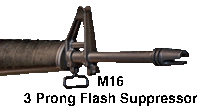 A jeep would run cases of C-rations out along the perimeter for the night meal. One of the guys with a M-16 with the older 3-pronged flash suppressor would hook it to the wire on the C-ration case and with a quick twist break all the wires loose. The old-timers quickly grabbed the best meals and the less-desirable meals were left for the newer guys. I only went on one “patrol” outside the perimeter wire.
A jeep would run cases of C-rations out along the perimeter for the night meal. One of the guys with a M-16 with the older 3-pronged flash suppressor would hook it to the wire on the C-ration case and with a quick twist break all the wires loose. The old-timers quickly grabbed the best meals and the less-desirable meals were left for the newer guys. I only went on one “patrol” outside the perimeter wire.
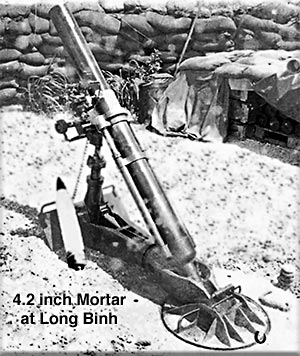 At that time, Long Binh apparently didn’t have any artillery fire support but lucky for me Lt. Bruce Bowers, an artillery officer fresh from the 1st Cav, asked for mortar-qualified volunteers to start up a 4.2” heavy mortar battery to provide flare and fire support for the perimeter. We signed out four gun tubes and a 3/4 ton Dodge truck for each tube and moved into old artillery emplacements out by themselves in the middle of elephant grass and bushes and trees not too far from an Army airfield with hangers. A large bunker with a ceiling made of multiple layers of huge wooden beams and sandbags served as our Fire Direction Center (FDC). We set up VHF radios and antennas, ran phone lines out to the gun positions and set up a generator in a deep un-used bunker, to try and force the sound straight up. We borrowed a 2.5 ton truck and went to Ben Hoa to load up on mortar ammo (flares and HE and some WP). The CO or XO and their jeep served as the mobile F/O, driving around the perimeter and calling in fire missions as they wanted. We would also get calls from "the hill” saying there was movement at pre-registered position so and so (from the electronic sensors) and we would shoot until they called back and told us “sensor destroyed”. We didn’t go out and investigate. Typically we would be up all night and sleep in the day. The LT signed out a starlight scope which we used at night on top of the FDC to watch for any movement - we had mongooses, monkeys, and small deer in our AO, as well as “Fuck You” lizards and “Re-Up” birds and other wildlife to listen to.
At that time, Long Binh apparently didn’t have any artillery fire support but lucky for me Lt. Bruce Bowers, an artillery officer fresh from the 1st Cav, asked for mortar-qualified volunteers to start up a 4.2” heavy mortar battery to provide flare and fire support for the perimeter. We signed out four gun tubes and a 3/4 ton Dodge truck for each tube and moved into old artillery emplacements out by themselves in the middle of elephant grass and bushes and trees not too far from an Army airfield with hangers. A large bunker with a ceiling made of multiple layers of huge wooden beams and sandbags served as our Fire Direction Center (FDC). We set up VHF radios and antennas, ran phone lines out to the gun positions and set up a generator in a deep un-used bunker, to try and force the sound straight up. We borrowed a 2.5 ton truck and went to Ben Hoa to load up on mortar ammo (flares and HE and some WP). The CO or XO and their jeep served as the mobile F/O, driving around the perimeter and calling in fire missions as they wanted. We would also get calls from "the hill” saying there was movement at pre-registered position so and so (from the electronic sensors) and we would shoot until they called back and told us “sensor destroyed”. We didn’t go out and investigate. Typically we would be up all night and sleep in the day. The LT signed out a starlight scope which we used at night on top of the FDC to watch for any movement - we had mongooses, monkeys, and small deer in our AO, as well as “Fuck You” lizards and “Re-Up” birds and other wildlife to listen to.
We also received clearance by radio daily from “the hill” on which grid coordinates were free-fire and which ones we definitely could not shoot in. One night we were cleared to shoot into an area historically off-limits to us so around 2 AM the LT decided to shoot some H&I into it… Afterwards the gun crews reporting hearing incoming sirens faintly in the distance (from towards Ben Hoa) and the radios went crazy and we were told to cease firing and not touch our plotting boards or gun settings. A handful of jeeps converged on our gun positions and officers checked over everything and eventually decided that we had been cleared into a grid square we shouldn’t have. The only other problem we had was a short round early one morning when shooting in the rain - these were particularly dangerous since we were shooting over our perimeter and our own troops. Luckily no one was injured.
In late September 1972 the word came through that Long Binh perimeter security was being turned over to Vietnamese Airborne units and our company standing down. Those of us with time left were reassigned to one of the few American units left in country, mostly Army aviation units which provided their own security. Our “shake and bake” E-5 Sgt. Harper got orders for D/17 in DaNang and I received orders for F Troop (Air), 4th Cav Regiment (F/4) at Tan My. We turned in our mortars and trucks and as we were leaving we watched four brand new 155 mm (8-inch) tracked artillery pieces with Vietnamese move into our old gun positions… we were proud!
I flew to DaNang and from there caught a ride to Tan My on an F Troop Huey. I was assigned to the security platoon (not the Blues) and I guarded the flight line and the various bunkers for a couple of weeks. I also went on one patrol off base walking through Tan My village looking for an AWOL trooper (didn’t find him).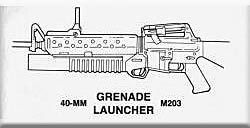 A short time afterwards someone asked me if I wanted to be in the Blues and I flew on a few missions but never had to land and help set up a perimeter around a downed aircraft. Shortly after I got out of the Blues they were all issued new M-203 “over and under” weapons. A few missions later as a door gunner I watched as a M-203 slid out of the doorway of our slick and down into the jungle. That Blue was charged a month’s salary.
A short time afterwards someone asked me if I wanted to be in the Blues and I flew on a few missions but never had to land and help set up a perimeter around a downed aircraft. Shortly after I got out of the Blues they were all issued new M-203 “over and under” weapons. A few missions later as a door gunner I watched as a M-203 slid out of the doorway of our slick and down into the jungle. That Blue was charged a month’s salary.
While in the Blues someone asked me if I wanted to be a huey door gunner. I said yes and a couple of nights later I was taken into a darkened hooch and told to qualify I would have to be able to field strip an M-60 blindfolded. 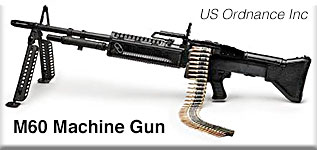 I could hear a circle of guys chuckling around me as I disassembled and reassembled the M60. I put one spring in backwards but was told I passed. Afterwards crew chief SP5 Robert “Bob" Totten took me under his wing and taught me the ropes. Bob mainly crewed on H-model Huey tail number 16286. Bob instructed me that I was responsible for rearming and cleaning the M-60s and making sure they always worked, and polishing the front bubble to the pilots’ liking (Lt. Dan Keirsey and Lt. Ron Holmes). It was also my job to stay with the aircraft and provide security anytime the crew chief or the pilots weren’t around. Another huey crew chief who helped me along and who I flew with a few times was Neal Avrett.
I could hear a circle of guys chuckling around me as I disassembled and reassembled the M60. I put one spring in backwards but was told I passed. Afterwards crew chief SP5 Robert “Bob" Totten took me under his wing and taught me the ropes. Bob mainly crewed on H-model Huey tail number 16286. Bob instructed me that I was responsible for rearming and cleaning the M-60s and making sure they always worked, and polishing the front bubble to the pilots’ liking (Lt. Dan Keirsey and Lt. Ron Holmes). It was also my job to stay with the aircraft and provide security anytime the crew chief or the pilots weren’t around. Another huey crew chief who helped me along and who I flew with a few times was Neal Avrett.

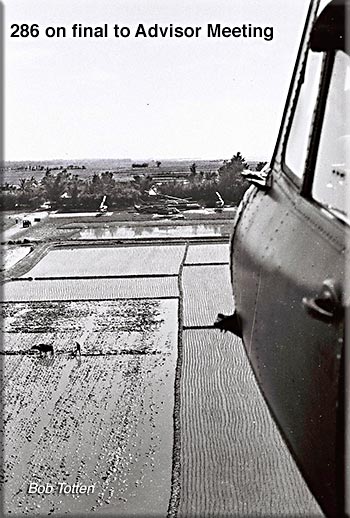 UH1-H 16286 (w/upturned exhaust) at Firebase T-Bone Dec 1972
UH1-H 16286 (w/upturned exhaust) at Firebase T-Bone Dec 1972
Once 286 flew to an advisor’s meeting at a small dry landing spot out in the middle of rice paddies. Bob and the pilots went into the meeting and I was left guarding 286. There was a handful of Vietnamese slicks parked there as well and but their entire crews went to the meeting. I walked around and looked at the old American markings on the Vietnamese slicks trying to determine what units they had served with previously. Bob and our pilots came back first and I mentioned to Bob that the Vietnamese didn’t leave anyone with their birds. He promptly walked over to the nearest slick and pulled the pins on their M60s and carried them back, commenting “this will teach them”…
I flew 47 missions mid-November 1972 through 28 January 1973. A few were pink or heavy pink team missions in the mountains, a couple were “maximum effort" SARs, other times we carried U.S. and S. Vietnamese advisors from place to place and as Forward Observers out in the AO, took ice and beer and other supplies to Special Forces advisors at firebases on top of mountains near the DMZ, carried the Blues, flew up and down along the coast to DaNang and back, flew nighthawk around Tan My and the U.S. Coast Guard Loran station a few miles from us, whatever needed to be done (hueys were the trucks of the air). I saw a couple of B-52 strikes from the air and also remember once providing high cover for a jolly-green helicopter doing a jungle penetrator extraction. It was sobering seeing downed helicopters and other aircraft, blown up tanks, APCs, and trucks (both U.S. and Russian-made) and captured equipment around I Corps.
The last F/4 mission in Vietnam was flown "maximum effort, first light” 28 January 1973 about 10 miles north of My Lai, near the former 23rd Infantry “Americal” Division base at Chu Lai (a long way south from Tan My - we flew down overnight to be on station early AM). The final cease-fire was declared over the radio at 7:55 AM, ending our mission and the "American War”.
One of my best remembrances of Tan My were the short-bottled coca-colas (bottled in France) that were sometimes available cold for $1 each (U.S. dollar, not MPC) at the little store on base. The food at Tan My was the best Army food I can remember, especially breakfast before flying - eggs, bacon etc right hot off the grille.
Everything in a can (cokes, beer) tasted like they had set out in the hot sun on a pallet for a year or two (which they probably had) and the only beer I remember is Schlitz. We used the little grapefruit and orange juice cans on our air-60s to help the ammo belt feed correctly.
I met Wayne Moose (another Charlottean) at Tan My and Joe McCourt at DaNang where he was repairing F/4 aircraft and we have been friends since.The best food I had in Vietnam was in an Air Force chow hall on the other side of DaNang airbase - Wayne and Joe and I went over there a couple of times while waiting for our freedom birds end of March 1973.
Thanks to all for the opportunity to serve in F/4 and ride along. My hat is off to all who served before me (which is everyone!).
PS:
I served nine months and 29 days in country - I was never offered R&R but because I volunteered for Vietnam under the Guaranteed Enlistment program - 1 year guaranteed in country - and the war ended, I qualified for an early out if I wanted it. The Army offered me SP5 to stay in and go to Fort Wainwright Alaska to test foul-weather gear in an infantry unit but I would have to extend a year… The oil business in Alaska had started and I thought about it but not very long. I took the early out and was also given “inactive reserve” status so I didn’t have to do any active reserve time. So I was in the Army a total of one year, 4 months and 29 days.
When I took the exit Army hearing test, they put me in a closet with a small glass window with a button to push when I heard a tone. I heard the lows but not the highs and the technician got in the booth and tested everything. I tried it again and failed again. He asked me if I wanted to get out of the Army today and I said yes. Accordingly he would point at me through the little window anytime I was to push the button (which I did). I passed the hearing test.
My hearing is fine today. I can only imagine how bad the hearing might be of anyone who stayed in Aviation (or Artillery) for their entire career.
